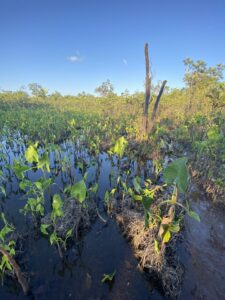Understanding the development of Amazonian peatlands
The Pastaza Marañon Foreland Basin (PMFB) in northern Peru comprises the largest peatland complex in Amazonia, storing 5.4 Pg C, harbouring unique biodiversity and supporting livelihoods of indigenous groups. However, there remains a strong need to increase our knowledge of these ecosystems: in spite of their importance as a carbon store they remain only partially scientifically explored and are not under any formal, large-scale protection. More information about the nature and origin of the landscapes in the different areas of peatlands would help to increase their visibility to policymakers and maximise their protection.
A particular knowledge gap is the lack of sampling of peat depth and age, and the associated vegetation, in the west of the PMFB. A preliminary measurement of peat depth in this area, in Datum Marañon province, found the deepest peat – 8.10 m – ever recorded in the entire peatland complex. Whether the age of these peatlands is older than recorded dates (up to 8000 BP) is unknown, as is the area of these deep peats and their associated vegetation. It is plausible that deep peats are extensive and distinctive in this region as it is located to the west of the Pastaza Fan which has periodically erased peat deposits further east during the last few thousand years. A related question is whether the age of the peatlands varies among basins and whether basal age is linked to variation in present day vegetation types.

The project will include fieldwork to sample the depth of peatlands in unexplored regions, develop a map of the basal dates of peatlands in the PMFB and test the links between the age of peatlands and the vegetation and successional patterns that are observed today. The studentship links to existing collaborations among the University of Leeds, the Instituto de Investigaciones de la Amazonia Peruana (IIAP), the Royal Botanic Gardens Kew and the University of St Andrews. The project will generate information that improves our knowledge of the distribution of peatlands in Amazonia, and will incorporate transferable skills in fieldwork, laboratory and statistical analysis.
